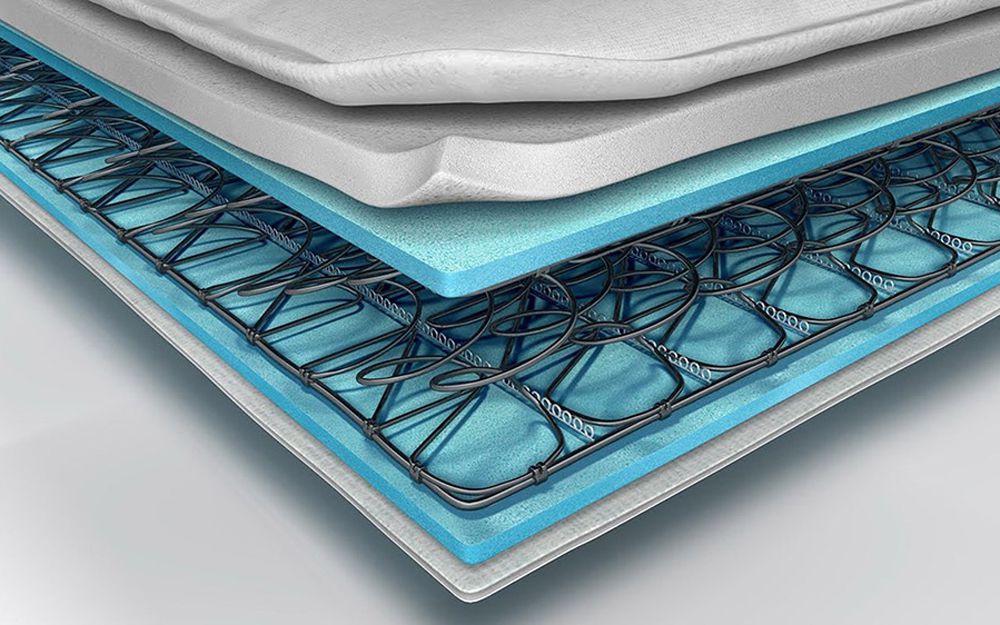What's Inside a Mattress?
Mattresses are made using a number of layers. All mattresses contain a:
- Support layer
- Comfort layer
- Cover
These layers can contain a variety of materials, all designed to offer you a comfortable and supportive sleeping surface. Read on to find out more!

Jump to
The support layer
The support layer is the main part of your mattress. This section gives your body the support it needs, and is the main contributor to how firm your mattress is.
The support layer is usually made from either springs or foam, or both.
Springs
The majority of mattresses contain springs. Springs are the metal coils within your mattress, which provide support for your body as you sleep.
There are two main categories of spring systems which are used within mattresses. These are either a standard sprung system, also known as an 'open coil' or 'bonnell' system, or a pocket sprung system.
Shop all pocket sprung mattresses
Foam
Where foam is used within the support layer, this is a high-density foam called reflex foam. Some mattresses are comprised only of foam, without springs.
All-foam mattresses are a type of non-sprung mattress. They are made from layers of foam, in different densities.
As there are no springs, foam mattresses tend to be lighter than sprung mattresses. This means you can easily move and turn them.
The high-density nature of foam helps prevent dust mites settling within the mattress. This means that foam mattresses are often naturally hypoallergenic, and can be a good option if you suffer from allergies.
The comfort layer
The comfort layer is found within the first few inches of the mattress surface. This layer can include a variety of materials of different depths, designed to offer you a luxurious, cushioned sleeping surface.
These materials are designed to offer you the ultimate in comfort. You can choose from a:
- Memory foam mattress
- Latex mattress
- Gel-infused foam mattress
- Natural mattress such as cotton, wool or silk
- White fibre mattress, such as an Eco Comfort mattress
Each type of material within the comfort layer will have different properties and benefits. For further information, we have advice pages that explain more about your:
Browse all of our mattresses today
Cover
The cover of the mattress is exactly that - the material used to cover the mattress.
There are two main types of covers: damask and knitted. They can vary quite significantly in terms of touch and functionality.
Damask covers
These covers provide a soft finish that's extremely hard-wearing. Made from a woven material that's often patterned, damask is a popular choice that offers great breathability.
Knitted covers
As the name suggests, this type of cover is knitted, using a soft-touch fabric with elasticated properties. Knitted covers are almost always used for mattresses that include memory foam or latex, moving as the foam moves. This type of cover also offers excellent breathability.
Cover finishes
Covers are then either quilted, tufted or may be plain, without a finish.
Quilted
Sometimes referred to as "micro-quilted", this type of finish is made by stitching the cover to the comfort layer. This creates a pattern on the top of the mattress. The ultimate in luxury, this type of cover offers supreme softness.
Tufted
Covers, and the mattress itself, can also be tufted. Tufted mattresses ensure that the mattress fillings remain in place and usually give the mattress a slightly firmer feel. This helps to ensure a good level of support for your body.
Plain
The cover can sometimes be left alone, without any tufting or quilting. This type of cover can often be found on rolled-up mattresses.
Special features
Covers often have special features:
Body temperature-regulating
Some covers can cool you down if you're too hot or warm you up if you're too cool! They absorb moisture and can store heat, releasing this when your body needs warming up as you sleep. They're usually hypoallergenic and breathable.
Look out for these brands on the product pages:
- Tencel
- Coolmax
- Cocona
- Hydraflex
Removable
Some covers are removable so they can be cleaned easily. Usually, these types of covers are dry-clean only. Always refer to manufacturer guidelines for further information.
Washable
Some mattress covers are not only removable but can be washed at home. Again, do check the manufacturer guidelines before doing so.














